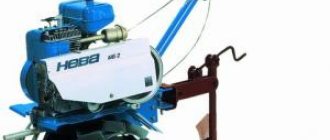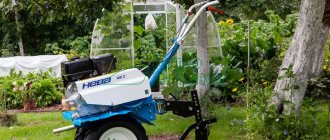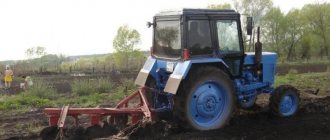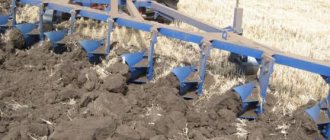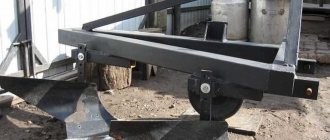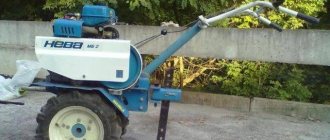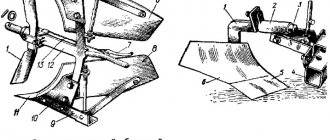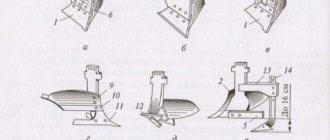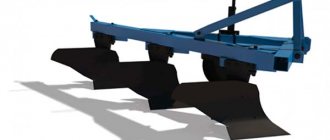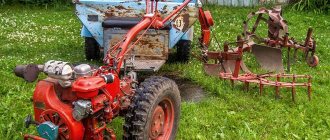- Preparing the walk-behind tractor for plowing the soil
on your plot of land - Assembling the plow and attaching the plow to the walk-behind tractor
- Adjusting the walk-behind tractor plow
for plowing the soil - How to plow with a walk-behind tractor.
| At the bottom of the article, you can watch a video on this topic. Enjoy watching! |
Preparing the walk-behind tractor for plowing
photo 1 Plowing with a walk-behind tractor
can only be carried out with the use of lugs, since the load on the walk-behind tractor when plowing increases significantly, and the use of lugs greatly facilitates this process. First of all, you remove the transport wheels and hubs on which the transport wheels of the walk-behind tractor are attached. You can purchase MTZ walk-behind tractors on the website pro-motobloki.ru.
After the transport wheels and hubs are removed, install other hubs on the drive axle of the walk-behind tractor, which come complete with the walk-behind tractor and are designed for installing lugs on them. The hubs for installing lugs are longer, which increases the track width of the walk-behind tractor and thereby ensures its stability when plowing the soil.
The hubs are connected to the drive shaft using studs and secured with cotter pins, after which lugs are installed on the hubs.
Plows for the Salyut walk-behind tractor
The plow is a working device for loosening, painting and turning over layers of soil 15-25 cm thick. The Salute walk-behind tractor, when combined with various attachments, perfectly performs many of the intended jobs - transporting goods, loosening, plowing the soil.
The set of attachments includes various units, including plows for basic types of soil cultivation.
To ensure strength, reliability and the ability to withstand sufficient loads, plows are made of durable steel. Their common design feature is a special metal comb used for plowing. Thanks to the specific shape, expanding upward, the earth does not pour back into the ditch, but is thrown to the sides.
Depending on the type of work performed, there are separate types of plows.
Types of plows:
- Single-body - equipped with one share, designed for plowing light soil. Indispensable in combination with a light walk-behind tractor when processing a small area.
- Reversible – designed for plowing heavy hard soil with medium or heavy walk-behind tractors. The ploughshare is made in the form of a feather bent upward, which, when working, lifts and turns up the lower layer of soil. Therefore, such plows have another name - reverse. After plowing, the soil becomes crumbly, making further processing much easier.
- Rotary - equipped with several blades, works on medium and heavy walk-behind tractors. Thanks to its unique design, it provides the highest productivity and allows you to plow hard soils no worse than soil tillers.
- Disc – cuts layers of excessively wet heavy soil. Disking is performed for pre-sowing soil preparation and surface loosening of stubble after harvesting.
Models
Attachments can be branded from the direct manufacturer or universal, which is suitable for walk-behind tractors of various modifications. In this case, manufacturers indicate which brands specific models are compatible with.
Plows adapted to the Salyut walk-behind tractor
There are a number of rules that will help you avoid mistakes when choosing a quality device. Compliance with them will help reduce costs, prevent damage, and make better use of the machine’s capabilities.
Plow selection criteria
- the stand should not be narrow and thin;
- Shortening the blade is strictly prohibited;
- the housing must be made of high-quality steel of sufficient thickness;
- Instructions for use are required.
Consider the size of the plow itself. For light walk-behind tractors, equipment with a small working width of up to 15 cm is used, for medium and heavy models, respectively, large sizes.
Hitches for walk-behind tractors
Walk-behind tractors are very functional machines for tillage. Their main purpose is plowing and loosening the soil, but the installation of additional attachments significantly expands the capabilities of the equipment. For example, with the help of a hiller you can hill up plants while simultaneously removing weeds; The digger comes in handy during the harvest season. Today there is a large assortment of canopies for walk-behind tractors on sale, using which you will greatly facilitate the performance of many tasks in your summer cottage and garden.
The hitch for the walk-behind tractor allows you to install additional equipment. The hitch also allows you to adjust the position of the canopies: depth of entry into the soil, angle of inclination, direction, etc. This element is installed on heavy units, because only they allow you to attach additional equipment. After all, the processing capabilities largely depend on the weight of the equipment. For example, light cultivators are unlikely to cope with plowing compacted soil, so there can be no need to install a plow or hiller - the machine simply cannot cope with these tasks. There are different types of this element: hitch for a plow of a walk-behind tractor, hitch for a cart (trailer) of a walk-behind tractor, etc.
Also on sale are universal hitches for walk-behind tractors, which allow you to simultaneously hang two pieces of equipment. Thus, the range of tasks performed is expanded. But, as a rule, all walk-behind tractors have a specific design, and each model has its own hitch. Therefore, we recommend that you first install a single hitch, which exactly matches the parameters of the unit, and then connect a universal one to it. As for the cost of purchasing this item, it is not worth saving. Only a high-quality reinforced hitch for a walk-behind tractor will allow you to work efficiently and will serve for a long time. Therefore, make your choice responsibly and do not purchase low-quality products.
In the Enkor24 online store you can buy hitches for walk-behind tractors Salyut, NEVA, Tselina, etc. Contact consultants for help to choose the model that exactly suits your equipment. Ask questions online or by phone. We deliver goods throughout the Russian Federation and to neighboring countries.
Hitches
Plows and hillers are connected to the Salyut walk-behind tractor through the S-13 beam and the S-20 bracket using a universal hitch. It is better to make adjustments through the hitch.
Important! The obligatory coincidence of the longitudinal axis of the regulator and the walk-behind tractor, plus the vertical position of the beam, will help to configure the equipment in the best way.
To optimally set up a plow without a hitch, it is first advisable to align the minimum parameters for plowing depth and width.
Adjusting the plow without a hitch:
- Align the minimum parameters for plowing depth and width;
- The support triangle must be in a horizontal position;
- Adjust the field board parallel to the movement.
In the future, the plowing depth, depending on the soil, can be adjusted correctly using special holes on the plow stand or by changing the angle of inclination of the body.
Plowing the land with a walk-behind tractor with an adapter
The quality of plowing and its convenience can be improved by turning the plow into a transport and arable module. To do this, it is attached to the frame of the adapter, not the walk-behind tractor. This type of plowing is easier and safer, but less maneuverable. The operating speed can be increased from 5 to 10 km/h.
Adapter – trailer to a walk-behind tractor or a mini tractor from a walk-behind tractor. The functionality of such a unit can be compared with the capabilities of a tractor. The range of tasks increases depending on the attachment.
Some models have a lever used for lifting. This makes controlling the mechanism easier and makes it possible to move it around the site.
Optional equipment
The Salyut has a specific design feature - its engine is shifted forward, which perfectly balances the plow mounted at the rear. Compared to the Neva and Oka, the center of gravity of the Salyut walk-behind tractor is shifted much closer to the surface of the earth, which makes it easier to control the walk-behind tractor, as a result, there is no need for additional balancing, and the load on the hands when moving is greatly reduced.
According to reviews from owners and repairmen of walk-behind tractors, it is most comfortable and efficient to work with Japanese engines. Pay attention to the video footage - the walk-behind tractor confidently walks along the furrow, without much effort from its owner. In the video you can see that when the operator releases the steering wheel, the walk-behind tractor with the plow continues to walk exactly along the track and plow at the same pace.
Depending on various tasks, axle extensions and metal wheels with weights are used. The wheels are installed with lugs that have a large supporting area so as not to fall through on loose soil.
Also, the lugs for the walk-behind tractor allow you to adjust the desired distance between the rows.
The universal hitch mode ensures a stable position of the machine during operation and makes it easier to adjust the plow angles in three planes. There is a variant of wheels with weighting, then the plow goes even deeper into the ground.
Video review of deep plowing with the Salyut-100 walk-behind tractor
Operation and reviews from owners of the Salyut-100 walk-behind tractor
Adapter for walk-behind tractors Salyut-100.
“Salyut-100” belongs to the middle class, a sort of MTZ-82 in the world of walk-behind tractors. It can effectively carry out the tasks of its lighter counterparts, and if it gets too tense, it can replace heavy equipment.
In small summer cottages, its capabilities are sufficient with a large margin. But in the conditions of personal subsidiary farming, Salyut will be able to fully reveal its potential. Here, 20-30 acres can be processed and hay cut for two or three cows; small loads up to 350 kg can be transported. In a small farm there is also a use for it: it is convenient to use in greenhouses, move feed or remove manure in farm buildings.
If from all of the above we traditionally highlight the advantages and disadvantages, we get something like this:
Advantages:
- Compact and maneuverable.
- Gear reducer.
- Reliable engines with high build quality from renowned manufacturers. Wide range of models to choose from.
- Sufficient power and weight for its class.
- Large selection of attachments.
- Acceptable price.
Finding flaws. Let's be as objective as possible. The design is simple to the point of disgrace, but as they say, everything ingenious is simple. Let's look at everything in order:
- The engine, in principle, there can be no complaints here. There is plenty to choose from, and if there are doubts about the quality of the Chinese, then there is no doubt about the quality of Briggs & Stratton or Subaru.
- Next is the gearbox. Fully geared, declared resource from 3000 m/hour. This is more than the service life of the motors installed on it, that is, most likely, more than one motor will work on this gearbox.
- Belt drive from the engine to the gearbox. The design is quite reliable and is used on most walk-behind tractors, both domestic and foreign. It all depends on the quality of the belts.
- At the base of all of the above is a strong frame made of stamped angles.
Is Salyut-100 a complete, balanced representative of middle-class walk-behind tractors, without any significant shortcomings? To verify this or prove the opposite, let’s turn to the happy owners of these miracle units for feedback:
- I have been mercilessly using the 100th Salyut for two years now. The Briggs & Stratton engine, no complaints, starts in cold weather without problems. In the summer, I successfully used cutters to develop an area that had not been plowed for 20 years, not without effort, of course, but also without strain. With a walk-behind tractor, I immediately took a cart, a blade and a snow blower. The loads it gave it were not small, it was impossible to count how much crushed stone it transported, and it always loaded along the sides, and even with a heap. During the work, I changed the belts three times, they often break, oil regularly according to the instructions, and spark plugs. I constantly have to adjust the tension of the belts, I don’t know if it’s like this for everyone or if it’s just my illness. But overall I’m pleased with the technology, it’s a completely reliable device.
- Before purchasing the updated hundred part, I had eleven years of experience in operating Salyut-5. I want to say right away that this is practically the same device. The cutters were slightly modified, the shift knob was moved to the steering wheel (which I really liked) and the clutch handle became plastic and more comfortable. The engines also became a little more powerful, but not significantly. The gearbox remained the same and this is one of the reasons why I took Salyut again and not another brand. My new walk-behind tractor has only worked for one season so far, all the attachments remain from its predecessor, I do everything. The potatoes are completely under the walk-behind tractor, when mowing I work with a mower and a rake, and transport work is also done on it. So far, no breakdowns, only the original belts broke in the first week. I found the right ones in a tractor shop, they have been working for almost a year now, I think they will last at least the same amount of time.
- My hard worker has been with me for three years now, he’s on his fourth year. The Lifan engine works perfectly, the Chinese factory has been making it with high quality for a long time, but the biased attitude remains. Another question is that you can run into a makeshift copy. But here everyone must watch for themselves; although the real Salyut is now assembling walk-behind tractors in China, they won’t put bullshit on their walk-behind tractors. As for the matter, what can I say, I threw away my original belts, and not a month has passed. I think it's defective, I bought the same ones, again the same story. I went to the tractor spare parts store and the guys picked up similar ones, the price is of course an order of magnitude higher than for the original ones, but they still work. My advice is to change the original belts right away. If this is not done, the original belts grind down the shoulder on the tension roller and after that, no matter how you tighten them, they will fly off. Otherwise the equipment is reliable. The gearbox is indestructible. Once I was developing a new site, wrapped reinforcement around the cutters, and almost flew over the walk-behind tractor, but the gearbox didn’t care.
Features of work
Attachments make it possible to expand the scope of application of the Salyut walk-behind tractor. You can effectively carry out absolutely all the work typical of rural areas. Undoubtedly, before starting work you will have to thoroughly understand the instructions, because the effectiveness of the equipment is, first of all, the correct settings and adjustments.
Rotary plow
Using a rotary plow, which has left and right multi-directional plows in its design, you can plow in forward and reverse directions. For the most effective work, it is better to choose a model with a plow adjustment, that is, the ability to adjust the cutting depth and tilt angle.
Plow installation:
- depress the pedal;
- fix the stand;
- after that the entire structure is rotated 90°.
Zykov's plow
Zykov's plow is significantly different in appearance from other models. The video review clearly shows that its main differences are carefully selected angles and a completely different profile of the plow-mold surface, which makes it possible to better paint the soil and turn over the layer. Such plowing almost completely eliminates weeds.
Here is a review of plowing with a Zykov reverse plow on a Salyut walk-behind tractor
Double sided plow
A double-sided plow (hiller) is used for hilling agricultural crops and destroying weeds. This device is used to cultivate the soil and cut a furrow for planting plants. Subsequent backfilling is done by turning on the walk-behind tractor in reverse. The units are distinguished with variable and constant working width.
A device with a non-adjustable width works in conjunction with a lightweight walk-behind tractor; 12 mm racks reliably protect it from overload. The most widespread are hillers with variable widths that can be adjusted. Such plows work perfectly in combination with Salyut 5DK walk-behind tractors. However, they have one drawback - the soil crumbles after passing.
Dutch hiller
Less known is the Dutch hiller, which forms narrow wedge-shaped furrows due to the movement of its wings not only to the sides, but also upwards. The formed bed ensures better contact of the planting material with the soil. Structurally simple, easy to manufacture, cheaper in cost.
Disc dipper
The disc hiller is much more productive, but its price is 3-4 times higher than usual. However, according to reviews, owners do not return to their previous devices after working with a disk hiller.
Important! All hillers work better in first lower gear. Since the forward speed decreases, which is comfortable for the operator, the traction of the walk-behind tractor increases.
The Salyut walk-behind tractor with a Japanese engine is the most successful choice of agricultural equipment in terms of a combination of proven quality and reasonable price.
By purchasing all kinds of attachments and attachments, you can further significantly expand the capabilities of the walk-behind tractor, successfully cultivating more than one hundred square meters of land.
Owner reviews
Nesterenko Andrey, Kyiv region:
“I talked a lot with the owners of walk-behind tractors, and I was convinced that with the Russian engine Salyut 5 DK 6 hp. inferior to the Chinese Lifang 6.5 hp. at times - it constantly overheats, the walk-behind tractor jumps. This is especially noticeable when working with a rotary plow.”
Kovalchuk Sergey, Zaporozhye:
“Over 5 years of working with Salyut, I became convinced that a walk-behind tractor with a professional Honda-CX 200 engine, although it costs a decent amount, is much more durable. With good seasonal load - plowing, loosening, digging up potatoes, etc., a cheap engine will not withstand a couple of years and will require repairs. I actually had to change to a new one after two years of work.”
Protasov Ivan, Sumy region, village. Apple:
“Engines are divided into professional, semi-professional and amateur; they differ significantly in price. If they are installed on the walk-behind tractor for its intended purpose, that is, to match the loads, then they will work reliably and for a long time. I am pleased with my Salyut 100-BS-V with the American Briggs&Stratton Vanguard engine. Please note that the Vanguard marking means a professional engine; I don’t recommend buying another one – it’s a waste of money.”
Ponomarenko Ilya, Saratov:
“I recommend a reversible plow that can be disassembled - the best choice, since it is possible to sharpen the knife or, if necessary, replace it.”
Motoblocks "Salute"
A prominent representative of Russian manufacturers are walk-behind tractors of the Salyut brand. The advantage of this unit is its balanced price-quality ratio. One of the first models, which is still in demand and remains on the market, is the Salyut-5 walk-behind tractor. The design of this unit is so simple and reliable that it easily won the love of the middle class population. The popularity of the model inspired its manufacturers to create a more advanced and modernized model - Salyut-100. This unit has increased power, due to which, coupled with a large number of attachments, the scope of its application has expanded.
What happens and how to choose attachments for the Salut walk-behind tractor
Motoblocks "Salut" and attachments for it are one of the best domestic units in the field of agricultural work. They are unique in their structure and functionality and are successfully used in Russia, Ukraine, Belarus and Kazakhstan. In dacha farming, walk-behind tractors are famous for their versatility due to the presence of high power and a large selection of attachments.
If you have a Salyut 5 walk-behind tractor, you can use it on your plot of land in the countryside if you buy attachments for plowing the soil, hilling and digging up potatoes, and for cutting hay. You can also purchase a pump for the walk-behind tractor to supply water, buy a trailer for transporting cargo, and even an option that will allow you to use the walk-behind tractor in winter, such as a snow shovel.
And even if you are a city resident with a private house, you can still take advantage of the Salute walk-behind tractor.
So, we mentioned that in rural areas you can use a walk-behind tractor to cut hay. You can also adjust this canopy for lawn mowing (rotary mower) - the only difference is the grass growth setting. Again, you can use the canopy to irrigate your lawn, or the canopy option for clearing fallen leaves in the fall.
How to choose a plow
Depending on the land cultivation work being carried out, it is necessary to select attachments. This rule also applies to the plow. Three modifications of the plow are most often used for plowing.
- Negotiable. Its design allows you to adjust the plowing depth. During operation, this plow forms a furrow and turns the cut layer of earth to the side, which is the simplest way. By improving the upper part of the plowshare, you can achieve better tillage. To do this, in the upper part of the unit, the ploughshare is bent to the left side with a slight inclination. During operation, the cut layer of earth slides along this bend and turns 180 degrees, thereby improving processing.
- Rotary. Used for more detailed cultivation of the land. By design, it has several blades, which allows you to increase the plowing depth. This plow not only plows the ground, but also crushes the cut layer of earth. This allows it to be used for hilling and making furrows for planting agricultural crops. The disadvantage of the design is that the tool can only be used on soft and medium soil. On hard soil, it will be necessary to initially cultivate with a reversible plow, then use a rotary plow, which increases physical costs and processing time. Also, the price of this design is the highest compared to others.
- Zykov's plow. It is a modified modified reversible plow. The plow design has proven itself when cultivating hard soil. Thanks to a larger number of settings, you can optimally prepare the equipment for work, taking into account all soil parameters and operating conditions. Adjusting the angle of inclination or, as people call it, the “angle of attack”, allows you to use this unit for processing any soil. To do this, you need to increase the angle of attack for processing hard soil types or reduce it for softer types of soil.
Installation
To reduce physical stress when cultivating the land with a walk-behind tractor, namely when plowing, it is necessary to correctly install and adjust the plow. When installing the plow on the unit, pay attention to the fastening of the hitch. It should be attached with one central cotter pin to the walk-behind tractor. This fastening provides a small amount of play, which will compensate for the load when cultivating problem areas of the soil. As the load on the plow increases, it will turn slightly to the side due to play, without changing the trajectory of the walk-behind tractor.
If you attach the equipment rigidly with two cotter pins to the walk-behind tractor, then all the forces will be transferred through the plow to the unit. You will have to exert a lot of physical strength to maintain an even trajectory of movement.
The installation of the plow itself is quite simple and does not take much time. Next comes the adjustment, which needs to be given maximum attention.
Assembling the plow and attaching the plow to the walk-behind tractor
A plow and a hitch are the two main components you need to plow the soil. To do this, it is necessary to assemble the plow and hitch into one unit in order to install the plow on the walk-behind tractor and adjust it for plowing.
Photo 2 The plow is attached to the walk-behind tractor using a hitch. Since hitches have different modifications and each model has its own differences, in some cases it will be necessary to carry out preliminary work to install the hitch on the plow. When the hitch is installed on the plow, we proceed to attaching the plow to the walk-behind tractor. Note: Attaching the plow to the walk-behind tractor through a universal hitch ensures reliable fastening of the plow to the towbar of the walk-behind tractor, and also allows for a number of precise adjustments of the plow for plowing the soil.
Types of hitches for walk-behind tractors
photo 3 If you and I use a universal hitch, as shown in photo 3, then I recommend not fixing the adjusting screw, leaving the lock nuts (A) loose, and also loosening the lock nuts (B) fixing the hitch to the plow stand. Now we can begin adjusting the plow.
How to adjust
To make the adjustment correctly, you need to know what kind of soil you are going to plow and to what depth. Here are brief instructions on how to adjust the plow on a walk-behind tractor.
- The plow should be positioned so that its central axis coincides with the longitudinal axis of the walk-behind tractor, and at the same time, the dimensions of the equipment do not extend beyond the excavation grips. This will ensure the stability of the unit during operation, and you can easily maintain a straight path of movement.
- To adjust the depth of tillage, prepare stands for the wheels of the walk-behind tractor at a height equal to the depth of tillage. It is necessary to install the unit on supports parallel to the ground. We release the plow stand with screws. It should descend and touch the ground. After this, we fix the plow to the stand with screws.
- To adjust the angle of the plow, lower it onto a level piece of ground. It should fit snugly across the entire plane to the soil. If this is not the case, loosen the clamp on the rack and turn it in the desired direction. Then secure the clamp.
- The angle of attack is adjusted by a screw located between the stand and the plowshare. By turning the screw clockwise, you decrease the angle of attack. This setting is suitable for soft soil. If you turn the screw counterclockwise, the angle of attack will increase, which will help you till harder soil.
How to install a plow for Salyut walk-behind tractors, see the video below.
How to install and plow a mounted plow
The main working parts of the tool are a metal ploughshare and a blade. The ploughshare carries out plowing, it cuts the upper layers of soil and directs them to the dump. And the blade wraps the earth raised by the ploughshare, crumbles it and throws it into the furrow. Thanks to this process, deep loosening of the soil occurs, during which it is saturated with oxygen and gets rid of weeds.
The picture shows what a plowshare plow looks like, designed for plowing with a cultivator or walk-behind tractor in the garden. Different models of plowing devices may have some differences among themselves, but mostly they are all designed this way.
Before you start plowing the ground with a cultivator or walk-behind tractor, assemble a removable plow. To do this, take two bolts and use them to attach the hitch to the rack of the mounted implement. The assembled unit is hung on the cultivator bracket, lightly fixed and then adjusted according to the following parameters:
- plowing depth;
- blade tilt angle;
- angle of inclination of the heel (field board).
To adjust to the required plowing depth, the motor-cultivator is rolled out onto stands 12-20 cm high and placed as level as possible, so that the field board is in full contact with the surface of the earth, and the stand is perpendicular to it. The mounted plow is adjusted to the required position at which it will plow, and then secured with an adjuster screw and a lock nut.
To adjust the angle of the blade, tilt the cultivator to the side. To do this, remove the stand from under the right wheel (or lug), leaving only under the left one. The nuts securing the hitch to the hitch are slightly loosened, the plow is slowly turned, giving it the optimal position for plowing.
Changing the angle of the heel (field board) is carried out by rotating the adjusting screw of the cultivator hitch. If it is necessary to increase the height of the heel lift relative to the plowshare, turn the screw clockwise and vice versa. When adjusting, be sure to ensure that the distance does not exceed 3 cm, otherwise the nose of the plow, when plowing in the garden, will begin to burrow deep into the ground and worsen the traction force of the cultivator, as well as a walk-behind tractor or a walk-behind tractor. After completing the adjustment, tighten all nuts well with a wrench. You can take a more detailed look at the process of setting up a plow for plowing with Salyut, Neva and other motor cultivators in the video.
After making the above settings, the plow is completely ready for use and you can try plowing in the garden. Before you start plowing thoroughly, especially virgin soil, you perform control plowing and evaluate whether the plow is adjusted correctly, what the depth of the furrow is and the quality of the soil dump. How to properly plow with a cultivator is well shown in the video using the Neva walk-behind tractor as an example. You can also watch a video about how the heavy Zirka walk-behind tractor behaves when plowing virgin soil.
How to plow with a walk-behind tractor and plow
If you have a standard plot of 6 acres of land at your disposal, then it is better to walk it with a walk-behind tractor from the light series. It weighs little and is easy to operate. Such a motor cultivator will cope with the site very quickly. It is customary to use cultivators and cutters as attachments for small areas. The processing technology is as follows: the mini-machine is installed at the edge of the site, starts up and moves forward at maximum speed, turning at the corners of the site. So, gradually the walk-behind tractor moves towards the center.
For large areas it is advisable to use medium and heavy cultivators. In this case, you simply cannot do without a plow:
- Control plowing is performed in two directions.
- During plowing, the position of the plow relative to the ground and the quality of the furrow are assessed.
- If there are no questions, they proceed to complete the full scope of work.
- The speed of the walk-behind tractor is increased, the furrows and the dump of the earth are smooth and neat.
This method is suitable for all types of soil. If work is carried out on hard and rocky soil, it is better to process it in two passes at different depths. At the second stage, in order to prevent the soil from sliding, waves can be made across the previous ones. When passing longitudinally, it is recommended to lay the wave between two old ones so that there is not a large distance between them.
Advice. When operating in hot weather, the engine requires time to rest and cool down. At the end of plowing, the plow should be disconnected, cleaned and washed from dirt, and left until next time.
When carrying out work related to plowing the land, it is necessary to adhere to certain instructions and rules:
- To begin with, control plowing is performed and the resulting furrow is analyzed.
- They adjust the plow, the quality of the moldboard and the depth of the strip.
- The furrow ridges should be at an equal distance from each other.
- The possibility of superimposing a new soil dump on the old one is excluded.
Knowledge about setting up a plow on a walk-behind tractor allows you not only to set up the equipment correctly, but also to perform high-quality plowing in the shortest possible time. Impeccable adjustment is the key to preparatory work on a personal plot.
What attachments does the walk-behind tractor work with?
Any experienced farmer knows that with the help of a walk-behind tractor, cultivator or other motorized equipment, almost all agricultural work can be mechanized, from cultivating the land to prepare it for sowing and ending with transporting the harvested crop. Motor units have become universal due to the possibility of using a variety of attachments. For example, for cultivating plowed land and cultivating virgin lands, not only moldboard and other plows were created, but also:
- harrows;
- hillers;
- rotary cutters;
- flat cutters-weeders.
Harrows are used to plow virgin soil, as well as for pre-sowing or post-harvest loosening of arable soil to a depth of 7-14 cm. Using harrowing with a walk-behind tractor or cultivator, the surface is leveled, moisture is covered, and weeds are destroyed. The working parts of such agricultural implements are metal teeth or spherical disks. In this video you can clearly see how to properly plow with a walk-behind tractor and a homemade harrow.
Using a hiller, you can hill up potatoes, cut furrows for sowing seeds, fill in planting material, and also sprinkle weeds directly in the area of the rows. Hilling devices come in single-row and double-row, with fixed and adjustable working widths, distinguishable both by their design and their efficiency. Here is a video of how the Neva MB2 walk-behind tractor performs processing with a mounted two-row hiller-weeder.
With a rotary cutter you can plow virgin soil, carry out pre-sowing and basic cultivation of plowed land. This agricultural implement allows you to mill, cultivate the land and qualitatively prepare it for sowing. It is capable of not only plowing the soil, but also crumbling large layers, mixing with fertilizer, crushing stubble particles, and leveling the sown area. Rotators for plowing come in different types, depending on the number of cutting elements. This video shows how to actually plow a walk-behind tractor with a cutter installed on it.
A flat weeding cutter helps to trim weeds, split and cut grooves without turning the formation, plow and crush the soil. Flat cutters come in all possible working widths and processing depths, which allows you to choose them for specific processing conditions of agricultural plots and crops. This video shows how to carry out processing with a mounted flat cutter in practice using the example of a Dnepr walk-behind tractor.
In addition to the listed removable tools designed to plow virgin soil and cultivate arable land, rakes, wood splitters, seeders, shredders, cultivators, rotary and segment mowers, shovels, sprayers, sweeping brushes, snow blowers, etc. are used with the motorized unit. Having a basic set of mounted agricultural implements, you can use a walk-behind tractor or a powerful cultivator to perform all kinds of economic tasks, in particular, pre-sowing plowing, sowing and planting crops, applying fertilizers, inter-row cultivation of crops, harvesting root crops, and seasonal harvesting of green fodder.
Attachments for walk-behind tractors
Attachments for walk-behind tractors are necessary components that increase the functionality of garden equipment and its productivity. Depending on the power of the units, manufacturers offer to buy attachments for cultivators to solve the following problems:
— hilling and plowing;
— spraying of plantings and harvesting of vegetable crops;
— soil cultivation, transportation, etc.
In the Electrolight online store, additional tools are presented in the product catalog. The choice can be made remotely or during a personal visit to the sales office in Rostov-on-Don. All models are certified, have warranty service and assembly in accordance with the stated technical documentation of the brand.
Cultivators for gardening and gardening, assembled
For tilling the soil and weeding in a summer cottage and vegetable garden, the attachment is sold assembled for walk-behind tractors produced by Salyut, Aurora, Don, Neva, Champion, etc. Installation of equipment does not require much effort, and spare parts can be replaced and repaired at the Rostov service center (Atlant market, Almaz). The attachment store offers to order components for cultivators in the following modification:
How much does it cost to plow a field?
Manual cultivation of the soil is a rather difficult task, and if it is also virgin soil, then almost impossible. Therefore, farmers and summer residents, in order not to work manually, try to acquire special agricultural equipment - cultivators, motor cultivators, walk-behind tractors, mini tractors and various accessories for them. The equipment will allow high-quality plowing of virgin soil and quickly cultivating plowed lands.
But not every owner of a farm or dacha land has the opportunity to purchase a whole arsenal of motorized equipment. Often the power of a purchased cultivator is simply not enough to cultivate virgin soil or plow an abandoned garden. In this case, you have to turn to the owners of more “serious” agricultural equipment for help - powerful mini tractors and tractors. These high-performance machines become especially popular during the pre-planting and post-harvest seasons. They quickly and efficiently process the field, cultivate, cultivate overgrown turf and virgin soil.
Of course, agricultural machinery services are not cheap. The cost of mechanized work performed by a tractor depends on various factors, in particular:
- prices for fuel and lubricants;
- dimensions of the treated area;
- the degree of neglect of the site, the presence of vegetation on it;
- relief and condition of the soil that will be processed;
- distances from the place where the equipment is parked to the place where it will work;
- the type of excavation work and the agricultural implements used to carry it out.
How much it costs to hire a tractor for plowing virgin soil or cultivating plowed land can be found out on thematic forums where experienced farmers and beginners exchange relevant information with each other and give practical advice. Typically, tractor owners calculate the cost of plowing as follows: all costs of processing + 45-50% (virgin soil, naturally, is more expensive). But it’s difficult to say exactly the final amount, since prices can vary greatly in different regions of the country.
The most expensive tractor work is considered to be plowing virgin and arable land using a disc harrow, a tillage cutter and a three-furrow plow (25,000 rubles/1-5 hectares). It will cost a little less to disk the earth and mow the grass if you work with a mini tractor using a mounted rotary mower and a tooth harrow (20,000 rubles/1-5 ha). But even at relatively high prices, the services of tractors and mini-tractors are used by many farmers, including owners of garden and country plots. Whatever one may say, plowing and cultivating without equipment is difficult and time-consuming. In addition, this is a very responsible process that cannot be done without time and financial investments.
Adjusting the plow on a walk-behind tractor
Auto mechanic, specializes in agricultural equipment
In order to grow a healthy and tasty crop on a plot of land, it is necessary, at least once a year, to plow and fluff up the established surface layer of soil. If this is a small area, that’s half the problem, but in the case of territories of tens of acres, plowing with a walk-behind tractor will be required. The plow clings to it, and the work goes much faster.
Such attachments are sold in specialized stores of agricultural machinery and equipment. The plowing device can be suitable simultaneously for different models of the same or different manufacturers. It would seem that there is nothing easier than attaching the device to a walk-behind tractor and starting plowing. This is not enough; you still need to properly configure and prepare the plow for work.
Use a plow with a walk-behind tractor to save time
Features of a plow on a walk-behind tractor
When choosing a walk-behind tractor, you should take into account the area to be processed and the condition of the soil.
The following types of walk-behind construction are distinguished:
- lungs;
- average;
- heavy.
The first option is used in areas with a small area. These are small-sized devices with an engine whose power does not exceed 5 hp. An essential feature of such motor cultivators is that they cannot be used for a long time. Due to their light weight and low-power motor, they are not able to dig deeply into the ground and quickly overheat.
The second type, in most cases, has rear-wheel drive and does an excellent job in large areas. The weight of the car has been increased and they can corner easily. Engine power can reach up to 12 hp.
Heavy representatives of walk-behind tractors are equipped with a power unit with a capacity of 15-30 horsepower. You can attach any additional equipment to them (potato digger, plow, trailer). Quite powerful equipment and at the same time very inconvenient when making a turn.
Kinds
With the help of walk-behind tractors, you can perform different types of agricultural work. Depending on the size of the area being processed and the demand for equipment in different fields of activity, equipment is purchased in light, medium and heavy classes.
Lungs
This mini-equipment is often called a motor cultivator. Its power does not exceed 4 and a half horsepower, which is why it costs less than medium and large units. The cost of the lightweight model is from 12 to 22 thousand rubles. The advantages include the light weight of the monoblock and the accessibility of processing inconvenient areas due to the small grip of the cutter.
The downside is the rapid overheating of the low-power motor, which means that you will have to work with such equipment for a short time. In addition, the depth of the excavated soil is less than that of a heavy walk-behind tractor. In addition, light equipment does not have mounts for additional equipment.
Average
This vehicle has rear-wheel drive. Engine power – 5-12 horsepower. The device is capable of processing an area of half a hectare. The walk-behind tractor weighs from 50 to 70 kilograms, its cost is 30-40 thousand rubles. Most walk-behind tractors in this category can be used to mount a plow and other equipment.
This technique has 2 gears and is equipped with a front headlight. Compared to a heavy walk-behind tractor, a medium walk-behind tractor is more maneuverable, but its plowing depth does not exceed 12 cm. And this is unacceptable for planting some plants.
Heavy
This equipment can plow vast areas, significantly larger than half a hectare. Engine power - 12-30 horsepower, price - 70-100 thousand rubles. A heavy walk-behind tractor can be used to attach a plow, trailer, hiller, potato digger and other equipment. It is easier and much faster to work with such equipment than with light and medium ones. The steering wheel and wheels are adjustable on it.
Disadvantages include the heavy weight of the model and lack of access to non-standard surface areas. In addition, such equipment has to be turned with effort. As for the types of plows for walk-behind tractors, they can be reversible with two bodies, which plow the soil using a moldboard, or rotary, plowing the soil thanks to rotating discs.
Do-it-yourself plow to walk-behind tractor
For someone who knows how to handle a tool and is trained to work with a welding machine, it will not be difficult to make a mechanism for plowing a garden with a walk-behind tractor on their own. It is enough to prepare the material: metal sheets, bolts, corner. Moreover, the products may not be new, but already used, but in good condition.
The ploughshare is made of a three-millimeter steel sheet. The remaining elements are made from a strip and a corner. The parts of the plow are connected to each other by welding and then the joints are cleaned with a grinder. Some are mounted in double rows to avoid a second pass at the beginning of the lane when driving in parallel rows.
Independent production of drawings and structural elements requires special attention. The precision of manufacturing parts will eliminate the possibility of disturbances in the functioning of the whole organism.
Modern designs of plows have a large number of varieties: single- and double-hulled, moldboard and non-mouldboard, rotary and rotary.
Advantages of homemade equipment:
- the ability to carry out accurate measurements and calculations on site;
- the cost of the finished structure will be cheaper than a similar factory one;
- selection of quality material;
- The assembly of the structure is carried out under constant supervision.
Preparing for plowing
Before planting seedlings and sowing seeds of agricultural crops, the soil must be prepared and the top layer must first be plowed. This work can be easily done by a motor cultivator plow. A correctly adjusted mechanism will create a neat and even furrow. To begin with, preparatory work is carried out with the walk-behind tractor itself, it is transported to the place where work begins, inspected and prepared for installation of the plow. Then it is fixed and adjusted, if necessary, sharpened. Only after this they start plowing.
Settings
The motor-cultivator is brought to the place where work begins in a disassembled state: the lugs and attachments must be removed:
- The wheels are dismantled to install special lugs instead. Without these devices, plowing the land will be problematic.
- Improves the stability of the walk-behind tractor. To do this, the hubs of the wheel pair are removed and other, more elongated ones are installed in their place. Thus, the distance between the lugs increases and the mini-tractor is better controlled while driving.
- Direct installation of lug devices.
Adjustment
For ease of adjustment, you need to take a beam 15 centimeters high in the amount of 2 pieces. They will serve as stands. Next, adjust the plowing depth. The most optimal is 16-20 centimeters. The entire procedure takes place on a flat horizontal surface. Now you can adjust the angle of inclination of the plow structure:
- Its rear part is raised by turning a special adjusting bolt. Thus, the depth of the furrow increases.
- By turning the bolt back, you can reduce the plowing depth.
Advice. The distance between the plow and the ground level should be maintained no more than 5 centimeters. If it is less than 3, the plow will dig into the soil and the quality of plowing will be poor. In this case, the engine will feel an increase in load, which will negatively affect its further performance.
Before starting the main work, you should plow a test strip and check the result. First of all, pay attention to the following:
- Strip depth, blade condition.
- While moving, monitor the progress of the plow.
- Smooth running of the walk-behind tractor.
- Engine operation and operator's physical workload.
The control strip is executed in the following sequence:
- The mini-tractor is placed on the edge of the cultivated plot of land.
- The gear is engaged and the clutch is smoothly depressed. When moving, you need to make sure that the walk-behind tractor with the plow runs parallel to the surface of the ground, without burying or rising too much. In this case, you don’t need to put in much effort; the motorcycle will move forward on its own.
- Check the result of the first strip passed; if it corresponds to the required depth, then work can begin in full.
Sharpening
The main structural element of the plow, which bears the main load during plowing, is the ploughshare. To effectively cut the ground, it must be well sharpened. Otherwise, dull blades will slow down the plow's forward progress. Many people try to make a plow themselves and, as a result, are not very happy with their work. And all because there is not enough knowledge about the production of a plowshare and how to sharpen it. The ploughshare must be removable with a cutting edge slightly thicker than 1 millimeter and an angle of 25 to 40 degrees. Of course, it is best to purchase a finished product, but you can try to make a good plow for a walk-behind tractor yourself, using diagrams and drawings, as well as a huge number of videos presented on the Internet.
Basic requirements for the ploughshare:
- the blade (its edge) should be located 2 cm below the skid;
- the blade and the working plane of the ploughshare must fit tightly together without gaps;
- the rear surface is attached to the base of the plow at an angle of 20 degrees, but no more;
- The cutting edge is made of carbide with a 4 mm chamfer.
A dull blade leads to poor penetration of the plow into the ground. This means it needs to be sharpened. How to do this correctly? The best place where such work will be performed at the highest level is a forge. In it, the material is first heated to a high temperature, then worn areas are corrected using a sledgehammer. Next, the blade is sharpened and hardened.
Modern manufacturers of agricultural machinery and tools produce self-sharpening blades. How to get out of the situation if there is neither one nor the other? In this case, use regular sandpaper. Sharpening occurs from the side of the influx of earth at a slight angle to the front surface.
Don't forget about fastening requirements
Installation
The time has come to install the plow on the walk-behind tractor. But first you need to attach the hitch to it:
- The tools necessary for the work are laid out: keys, hitch, plow.
- The furrow depth is adjusted. The hole of the hub and the plow stand are compared.
- The holes are secured with a common bolt.
- The installed hitch on the plow is fixed with bolted connections.
- The structure is hung on a walk-behind tractor.
Tips for using a walk-behind tractor
Cultivation. Plowing. Hilling
Plowing Plowing with fireworks is a pleasure: both easy and high quality.
Hilling a 2-row hiller cannot show its good side even with SALUTE.
| With a cutter, SALUTE runs on its own, you just have time to point it where it needs to be. | Hilling But the disk hiller is a song! And easy, and effective, and fast! |
| Digging potatoes for SALUTE is a simple matter. | Here it is: a successful combination of a walk-behind tractor and a plow! In this case, it is Zykov’s plow and SALYUT. On heavy chernozem, and even on stubble, there is almost a complete rotation of the layer and 100% incorporation of crop residues. Not every tractor plow can cope with such a task, but here is some kind of walk-behind tractor... |
| Plowing Oh, beauty! Well, who else doubts that you can plow with a walk-behind tractor? | Variant of the SALYUT walk-behind tractor with a hay mower. |
Reviews on the use of the Salute walk-behind tractor
The SALYUT walk-behind tractor is available with the following engines:
- 1 — semi-professional engine “Intek I./C” Briggs & Straton (USA) — 6.5 hp.
- 2- professional engine “Vanguard” Briggs & Straton (USA) with increased engine life - 6.0 hp.
- 3- engine “Honda GC-190” (Japan) -6.0 hp.
- 4- professional engine “Honda GX 200” (Japan) – 6.5 hp.
- 5- “Lifan” engine (China) – 6.5 hp.
Technical characteristics: integral walk-behind tractor (handles rotate 180 degrees), cutter grip 35/60/80 cm, solid rubber wheels, 1 drive belt, gear reducer, 1 power take-off pulley, weight 80 kg. By rearranging the pulleys, you can expand the speed range of the walk-behind tractor from 3 to 11 km/h
The SALYUT walk-behind tractor is already a serious machine. Not 10, not 20 or even 30 kg, but as much as 80! Therefore, we did not stand on ceremony with him. First of all, we decided to try it on the hardest work - plowing.
To improve the grip of the wheels on the soil, we put on the heaviest wheels available on the SALYUT. As a result, the walk-behind tractor became 30 kg heavier. The plow was installed on a universal hitch, which allows you to adjust the angles of inclination of the plow in three mutually perpendicular planes and achieve a stable position of the plow during work.
The first field we went to was quite clean, the soil was not heavy, with sand, but not enough moisture. But it will do for testing. It didn’t take long to set up the plow – after 15 minutes they were plowing without stopping. The plow easily cut the soil, which crumbled and turned around and fell into the furrow. The walk-behind tractor walked obediently and steadily along the furrow. It was easy to drive; sometimes even one hand was enough to keep the car moving. Of course, SALYUT is far from the first walk-behind tractor that we have to hold in our hands. Therefore, setting up the plow for high-quality and easy work was not difficult. Anyone who will do this for the first time will have to tinker, but we can definitely say: SALUT is much easier to set up than Neva. This is due to the significantly lower center of gravity and the engine shifted forward, which balances the plow mounted at the rear.
This design feature also affects when working with a cutter: if the Neva needs to be kept from tipping over, then the SALYUT seems to spread above the ground. It doesn’t take long to adapt; after just 50 meters you can walk with the cutter easily and confidently. The clumping of the soil, just like with the Neva, is regulated by the rotation of the cutter, but the cutting of the soil is more uniform. This is clearly visible to the eye; you don’t even need to take measurements. Apparently, this is due to the fact that the cutter knives of adjacent plates overlap in the cutting width, while in Neva the knives of adjacent plates do not reach each other by about 8 cm.
And, of course, we tried a 2-row hiller with SALYUT. The fact is that no matter how much we tried to work with this hiller, we never liked it. Maybe it will be better with SALUTE? No, and then there was a mistake. The walk-behind tractor turned to the side, so much so that it was unbearable to hold it straight. This is explained by the fact that if one of the hillers goes a little deeper in the soil, the soil immediately slows it down. And in general, soil is a heterogeneous medium. So the walk-behind tractor turns from side to side. Let's try a disk hiller. This is truly class! Both easy and fast. With a 1-row disc hiller we cut ridges much faster than with a regular 2-row hiller. And most importantly, don’t get tired! To make it more efficient, we place the walk-behind tractor on high wheels.
Well, how does SALYUT work with a root digger? Pretty confident. We often heard from owners of walk-behind tractors who tried to dig potatoes with them: “I won’t pick up a shovel again!” We confirm: this walk-behind tractor pulls the digger like a needle and thread.
For the sake of objectivity, it should be said that the soil on which we tried SALYUT is average in severity. To test the capabilities of the walk-behind tractor, we went to look for real black soil. We found it, and even with stubble (see photo 6). Let's try it here. We drove into a field with a plow. We passed the first furrow. As always, not deep. The main thing is that it is straightforward. Behind it they laid a second furrow, also not deep. Again, the main thing is to be straightforward. And on the third furrow they tried to run the plow deeper. And then it started: the wheels are slipping - they lowered the heel of the plow lower, the plow deepens - they lowered the toe of the ploughshare, the wheel comes out of the furrow - they turned the beam to the left, etc. We did two passes while setting it up. But when we set it up... Off we go. As they say, they caught it. Once again we are convinced that the plow must be configured correctly. If you take the time, it will pay off with interest: it won’t be plowing, but sheer pleasure. Lightweight, fast and high quality.
Now about the disadvantages. There is one inconvenience that we experienced, it was on turns. The wheels do not rotate relative to each other, and the SALYUT does not have a differential, like the Neva. The factory workers say that they do not want to weaken the gearbox with the differential. Maybe they know better.
In conclusion, let’s say: with the SALYUT walk-behind tractor you can quite confidently “plow” the expanses of your vegetable gardens.
